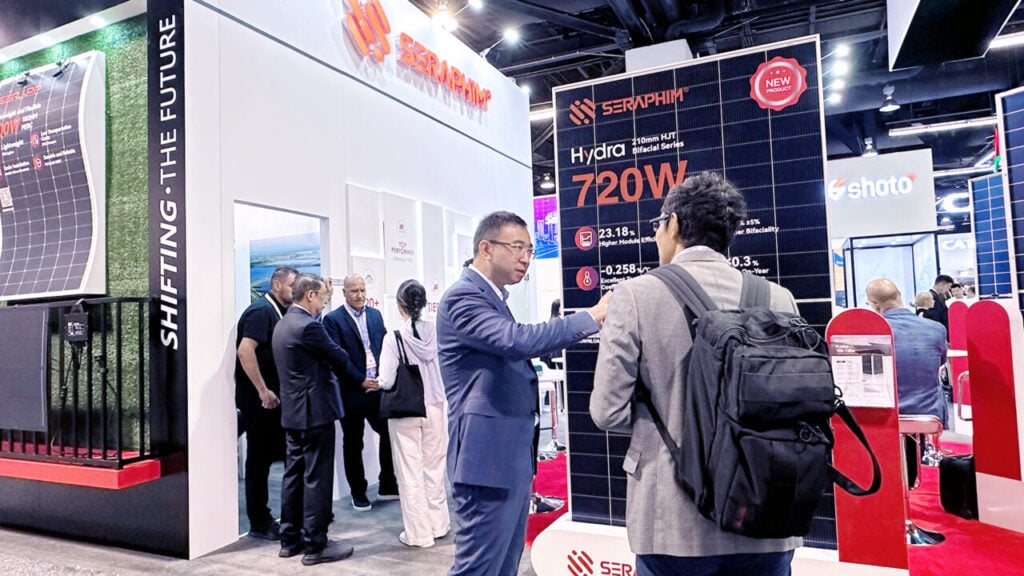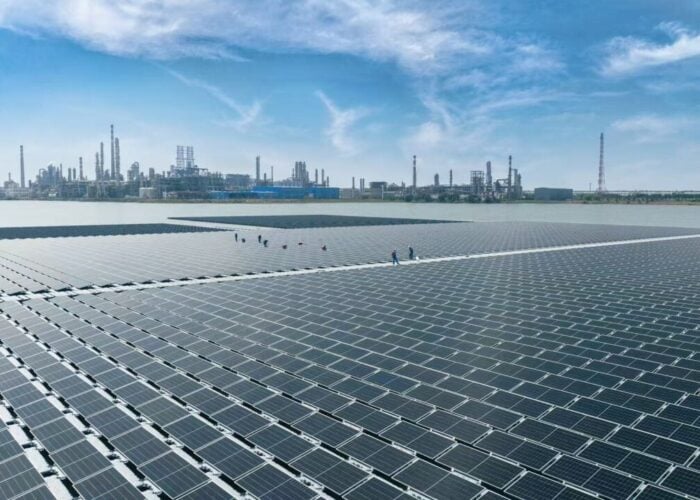
At RE+ 2024, one of the most prestigious solar exhibitions held in the US, Seraphim reasserted its presence by unveiling its latest suite of cutting-edge solar modules. Supported by a dynamic sales and marketing team, Seraphim presented its Hydra heterojunction (HJT), Sable tunnel oxide passivated contact (TOPCon), Nebula and flexible module series. These advanced solutions—tailored for large-scale ground-mounted projects, commercial and industrial (C&I) applications and residential rooftops—gathered widespread attention from industry professionals.
Having been among the first Chinese solar manufacturers to enter the US market, Seraphim first made a considerable impact before temporarily exiting due to strategic realignment.
Unlock unlimited access for 12 whole months of distinctive global analysis
Photovoltaics International is now included.
- Regular insight and analysis of the industry’s biggest developments
- In-depth interviews with the industry’s leading figures
- Unlimited digital access to the PV Tech Power journal catalogue
- Unlimited digital access to the Photovoltaics International journal catalogue
- Access to more than 1,000 technical papers
- Discounts on Solar Media’s portfolio of events, in-person and virtual
Today, Seraphim returns with renewed vigor and refined strategy, poised to reclaim its market presence.
“We re-entered this market last year,” said Dr. Insan Boy, vice president of Seraphim, during an exclusive interview with PV Tech at the RE+ 2024 site.
“Although our timing might be considered a little late, Seraphim is no longer a newcomer in the US market. The question is no longer about who we are, but whether we can meet current US demand. Basically, we’ve completed the stage of zero to one, and heading from one to N.”
He added that while the US market is unique, every company must navigate its own path to succeed
Strategic insights into the US solar market
In recent years, the US solar market has experienced consistent growth, becoming a critical driver of the country’s energy transition. According to the Solar Energy Industries Association (SEIA), 2023 witnessed the addition of 32.4GW of solar capacity, surpassing the 30GW mark for the first time. In 2024, the SEIA expects the US to add 38GW, with annual installations expected to average 40-50GW from 2025 to 2030.
This transition has been accompanied by increasing diversification in the supply chain and a move towards the localisation of manufacturing.
Insan commented: “It is generally acknowledged that the US market is huge, attracting many players, and we are actively participating as well. However, we’ll carefully select projects based on our company’s capability. With this 50GW annual installations anticipation, we’ll be content even if we capture just a 2% or 3% market share considering our production capacity, so we allocate shipments based on regional market conditions.”
He also acknowledged the challenges posed by trade barriers, such as the imposition of 50% tariff on imported solar cells, announced on 13 September. Drawing from past experiences, Seraphim believes that these obstacles demand careful consideration for Chinese solar companies, especially regarding decisions to establish manufacturing operations in the US.

“Although the US market is promising, we have a clear understanding that it’s also filled with risks,” Insan explained. “Localisation and subsidies are not necessarily equal.”
“To navigate these complexities, Seraphim has adopted a refined strategy, offering robust technical support to partners while optimising our rich experience in cell technology and global module manufacturing footprints, providing US customers with reliable and high-quality products,” he added.
Regarding global manufacturing, Insan noted: “We’ve invested and built factories in countries such as South Africa and Indonesia. As for Turkey, we’ve started our presence in Turkey since 2019, where we partnered with a very strong local company and achieved the top market share. These strategic local partnerships and manufacturing footprints will help us better serve the US market.”
The manufacturing diversification, alongside strategic collaborations with a win-win approach, has allowed Seraphim to expand its global footprint in photovoltaic manufacturing rapidly. By close of 2023, Seraphim’s products were operational with excellent performance has been widely verified under various natural conditions in more than 120 countries and areas. including the US, Germany, Japan, Vietnam, Australia, the Netherlands and Brazil.
Sustainable profitability: the cornerstone to long-term growth
As the photovoltaic industry undergoes another period of structural adjustment, the competitive landscape is becoming increasingly challenging. Leading manufacturers, new entrants and cross-sector companies all seeking ways to break through this challenging cycle.
The industry is currently facing internal pressure and external barriers, with disorderly internal competition and cutthroat pricing. Recently, module prices in several regions have continued to drop.

Reflecting on the current state of the industry, Insan expressed his concern: “The most pressing issue the industry faces today is massive production capacity combined with bottomless price wars. There’s never a winner in price competition—it only leads to a situation where no one can make a profit. Seraphim’s focus this year is on profitable projects, that offer sustainable returns, as maintaining profitability is essential for long-term viability.”
“It’s hard to say,” said Insan, when asked about how long he expects these challenging conditions to continue. “[The] market’s current imbalance between production capacity and actual demand will take time to stabilise. In terms of capacity, China alone has over 1,000GW of production capacity, while global installations are merely expected to reach 600GW. There’s a significant gap to bridge. I personally expect things to get better only after the second half of next year, so we’ll need to endure until then.”
Weathering the storm
Insan went on to highlight Seraphim’s resilience, saying: “This year marks Seraphim’s 13th year of experience and its ability to adapt to evolving markets. We started from scratch and now ship 6-7GW of modules overseas annually, placing us among the industry leaders. Seraphim was one of the first Chinese solar companies to enter the global market and has demonstrated a keen ability to recognise emerging opportunities in new and established markets alike. Now, nearly every country in the world recognises solar energy and is installing PV systems. “
According to Insan, Seraphim’s strength lies not only in its extensive market experience but also the expertise of its management team. The team has traveled the globe, entering both untapped and highly competitive markets, ultimately selling modules in over 120 countries.
“Our customers are not only the direct beneficiaries of our products and services, but they also form the foundation of our brand’s reputation and market position. We’ve built a reputation of professionalism, innovation and exceptional quality,” Insan said.
In his concluding remarks, Insan emphasised the critical importance of perseverance. Over the past 13 years, Seraphim has experienced multiple challenging cycles of the photovoltaic industry. Through disciplined manufacturing and strategic collaboration, the company has charted a path towards sustainable growth.
As Seraphim continues to evolve, the company remains focused on innovation, operational excellence, and forging strong partnerships, paving the way for continued success in the ever-changing photovoltaic landscape.






